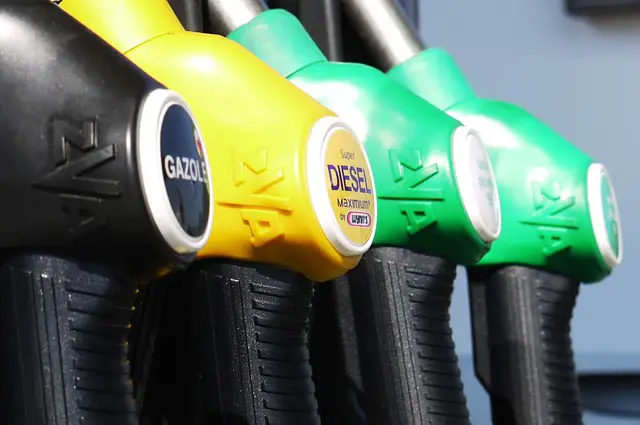Naphtha and gasoline are both liquid petroleum products used as fuel, but gasoline has a higher octane rating and is typically used for automobiles, while naphtha has a lower octane rating and is used in other applications such as petrochemical production.
What is naphtha?
(Photo by Ron Lach)

Naphtha is a petroleum product that is used as a solvent and as a raw material for the production of gasoline. It is a clear, colorless liquid with a pungent odor. Naphtha is produced during the refining of crude oil and can be either light or heavy. Naphtha is highly flammable and should be kept away from heat or open flames. It should be stored in a well-ventilated area. Naphtha is used in many industries, including the petrochemical industry, as a solvent for cleaning products and as a fuel for engines.
What is gasoline?
(Image by David ROUMANET from Pixabay )

Gasoline is a refined petroleum product that is used as a fuel in internal combustion engines. It consists of a mixture of hydrocarbons, including alkanes, cycloalkanes, and aromatics. Gasoline also contains small amounts of additives such as detergents and antiknock agents.
The boiling point range of gasoline is 30-210 degrees Celsius. Gasoline vaporizes at a lower temperature than other fuels such as diesel, kerosene, and LPG because it is a lighter weight hydrocarbon. The vaporization enables the gasoline to be drawn into the engine where it ignites.
Most automobiles require unleaded gasoline because lead emissions from older cars damage the environment. However, some race cars still use leaded gasoline because it provides more power due to its higher octane rating.
Gasoline is a very volatile fuel and must be handled with care. It is flammable and explosive, so extreme caution must be used when storing or handling it.
Naphtha Vs. Gasoline – Key differences
Naphtha and gasoline are both liquid hydrocarbon fuels derived from crude oil, but they have some significant differences in terms of their physical and chemical properties, applications, and processing methods. Here are some key differences between naphtha and gasoline:
Boiling point: Naphtha has a lower boiling point than gasoline, which means it evaporates more easily and has a lower flash point. This property makes naphtha more volatile and less stable than gasoline.
Octane rating: Octane rating is a measure of a fuel’s ability to resist “knocking” or detonation during combustion. Gasoline has a higher octane rating than naphtha, which means it can withstand higher compression ratios and temperatures without detonating. This property makes gasoline more suitable for use in high-performance engines.
Applications: Naphtha is used primarily in the production of petrochemicals such as plastics, solvents, and synthetic fibers. It is also used as a fuel in some industrial processes such as cement and steel production. Gasoline, on the other hand, is primarily used as a fuel for automobiles, boats, and small engines such as lawnmowers and chainsaws.
Processing: Naphtha is produced during the refining process by distilling crude oil at a temperature range of 60-200°C. It is a mixture of light hydrocarbons such as pentanes and hexanes. Gasoline, on the other hand, is produced by further refining naphtha and adding various additives to improve its performance.
Both naphtha and gasoline are derived from crude oil and have similar chemical compositions, they differ in their boiling points, octane ratings, applications, and processing methods. Naphtha is typically used in the production of petrochemicals, while gasoline is used as a fuel for transportation and small engines.
Can naphtha be used as gasoline?
Naphtha can be used as gasoline, but it is not as refined as gasoline and therefore not as clean burning. Naphtha is a heavier hydrocarbon liquid that is distilled from petroleum. It can also be made from coal tar or wood. Gasoline is a mixture of hydrocarbons that are vaporized and then condensed to form a clear, flammable liquid.
What is diesel?
Diesel is a type of petroleum product that is used as a fuel in many diesel engines. It is similar to gasoline in many ways, but there are some important differences. Diesel has a higher energy density than gasoline, and it burns more slowly. This means that diesel engines can be more efficient than gasoline engines, but they also tend to produce more emissions.
What is the difference between natural gas and naphtha?
Natural gas is a colorless, odorless gas composed primarily of methane and used for heating, cooking, and electricity generation, while naphtha is a liquid fuel derived from crude oil and used primarily in the production of petrochemicals. They differ in their source, composition, properties, and applications.
How is naphtha converted to gasoline?
Naphtha can be converted to gasoline through a refining process called catalytic reforming, which rearranges the molecules in naphtha to produce higher-octane hydrocarbons. Here are the basic steps involved in the catalytic reforming process:
Pre-treatment: The naphtha feedstock is first treated to remove impurities such as sulfur, nitrogen, and metals that can interfere with the catalyst and reduce the efficiency of the process.
Catalytic cracking: The pretreated naphtha is then fed into a catalytic cracking reactor, where it is mixed with hydrogen and passed over a catalyst made of platinum or another metal. This step breaks down the larger hydrocarbon molecules in naphtha into smaller fragments, which are then reassembled into higher-octane compounds.
Separation: The product stream from the catalytic cracking reactor is then cooled and passed through a series of distillation columns to separate the gasoline from other products such as light gases, naphtha, and heavy oils.
Treatment: The gasoline product may then be treated with additives such as anti-knock agents, detergents, and stabilizers to improve its performance and stability.
The resulting gasoline product has a higher octane rating than the original naphtha feedstock, which makes it more suitable for use in high-performance engines. Catalytic reforming is a key process in the production of gasoline and other high-octane fuels from crude oil.
What are the uses of naphtha?
Naphtha has a variety of uses, the most common of which is as a solvent. It is also used as a cleaning agent, degreaser, and paint stripper. Naphtha is also used in the production of plastics, resins, and adhesives. It can also be used as a fuel for camp stoves and lanterns.
What are the disadvantages of naphtha?
Naphtha is a highly flammable liquid which can pose a serious fire hazard. It is also volatile, meaning that it easily vaporizes and can cause explosions if not handled correctly. Naphtha is also harmful to the environment, as it is a major source of air pollution.
Featured Image By – John Cameron on Unsplash









